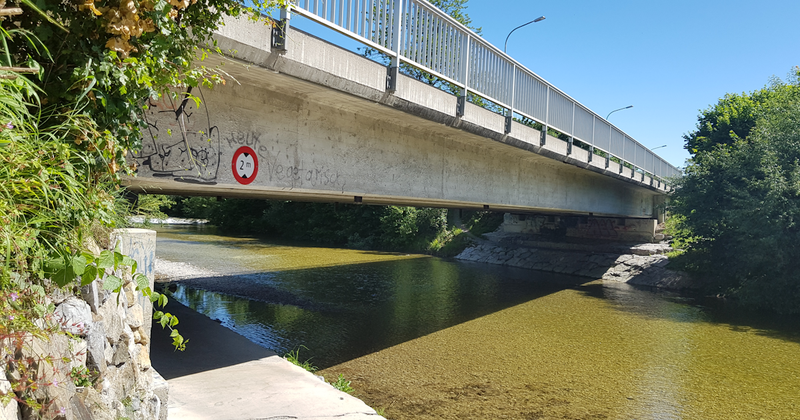Tössbrücke Wila skew-angled bridge
About the project
The recalculation of the bridge was conducted based on the request of the Civil Engineering Office of the Canton of Zurich. As part of an expert assessment of the bridge's shear-carrying safety, the specific tendon anchorage of the post-tensioning system was found to be insufficient at one of the corner supports of the skew bridge's superstructure.
Engineering challenges
The superstructure has various statically relevant features, such as inadequate detailing of the shear reinforcement and the influence of the unique post-tensioning system on the girder supports. These were all considered in the subsequent detailed structural analysis.
The longitudinal girder webs are shear-reinforced with stirrups. Some legs are only partially anchored at the top of the cross-section while being fully anchored by bends at the bottom. The rest of the stirrups fulfills the detailing requirements according to the Swiss code.
The support region of the most heavily loaded web was analyzed in detail using a level-of-approximation approach with an increasing degree of sophistication. At first, the design equations from the Swiss code were used to estimate the shear resistance. This standard approach had to be modified based on scientific literature and experimental research to allow for the inadequate detailing of the stirrups. The analyses were then further refined using detailed truss models. As a final step, the local force flow was analyzed using non-linear finite element (FE) analyses based on the elastic-plastic stress fields method using IDEA StatiCa Detail.
The inelastic FE analysis provided important verification of the previous results, which arose from the strut-and-tie models. It considered the distributed shear reinforcement in a more detailed manner and, at the same time, automatically investigated the corresponding stress state in the concrete using the optimum local inclinations of the compression field. Based on the explicit modeling of the reinforcement bond, this approach allowed detailed consideration of the specific anchorage conditions of the stirrups. In this sense, it represented a further refinement of the strut-and-tie analyses.

Switzerland
Since IDEA StatiCa Detail accounts for deformation behavior and strain compatibility, it also provided valuable insight into the deformation demand of the materials. Especially for members with low shear reinforcement ratio very low angles of the concrete compression field are likely to occur. On one hand, the corresponding large transverse strains reduce the concrete compression strength. On the other hand, the resulting stirrup strains can reach a critical level and, thus, be decisive for the ultimate capacity of the girder. While both deformation-dependent effects are difficult to consider in a strut-and-tie model, they are explicitly accounted for in IDEA StatiCa Detail. The program reduced the concrete compression strength depending on the local transverse strain state and also checked the stirrup strains. The implementation of the tension chord model in IDEA StatiCa Detail was of great value for the quantification of the reinforcement strain concentration in the cracks and, therefore, for the realistic evaluation of the deformation demand at low compression field angles.
Results and solutions
For a large part of the structure, it was possible to demonstrate sufficient structural safety based on the detailed analyses. However, at one of the bridge's 10 bearings, a deficiency remained due to improper anchorage of the flexural reinforcement at the support. This conceptual weak point was retrofitted with a specifically developed strengthening measure to guarantee safe continued operation for the structure's remaining useful life, of a few years, without significant restrictions on use. To reinforce the relevant support region, an external steel tension chord was installed as an additional flexural reinforcement to carry the longitudinal tensile force due to shear at the support. The bond with the existing structure was created mechanically by drilled-through threaded rods and glued-in dowels, as well as a contact connection to the current structural bearing and the end cross girder.
The measure was implemented while the bridge was operating, with reduced traffic. The entire planning and construction management of the retrofit campaign was conducted by dsp. The scan of the existing reinforcement necessary to determine the detailed drilling positions was also carried out by dsp using a Profometer and Georadar.
Prueba IDEA StatiCa gratis







